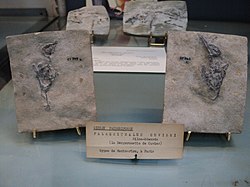You can help expand this article with text translated from the corresponding article in French. (November 2021)Click [show] for important translation instructions.
|
| Palaegithalus | |
|---|---|
 | |
| Counter-print and footprint of the fossil, on display in a display case in the Paleontology Gallery of the National Museum of Natural History in Paris, France. | |
| Scientific classification | |
| Kingdom: | Animalia |
| Phylum: | Chordata |
| Class: | Aves |
| Order: | Passeriformes |
| Family: | Paridae |
| Genus: | † Palaegithalus Milne-Edwards, 1869 |
| Species: | †P. cuvieri |
| Binomial name | |
| †Palaegithalus cuvieri Gervais, 1852 | |
Palaegithalus [1] is an extinct monotypic genus containing the only species Palaegithalus cuvieri, sometimes referred to as Cuvier's wagtail, is an extinct species of bird from the Upper Eocene, about 34 to 37 million years ago. This small long-legged bird was formally described by Paul Gervais in 1852, from an "ornitholite" found in 1781 in the quarries of Montmartre and previously studied by Robert de Lamanon, Alberto Fortis and Georges Cuvier, the specific epithet being dedicated to the latter.
Contents
The taxon was first placed by Gervais in the genus Sitta (nuthatches), but its membership in the group Sittidae was later disputed. Transferred for a time to the Paridae or Motacillidae (earning it the nickname of wagtail), it seems in reality not to belong to the order Passeriformes (passerines). If its systematic placement is still uncertain because of the poor condition of the fossil, the species is at least placed in its own genus, Palaegithalus, placed in the family Paridae or related to Sylphornithidae, an Eocene group close to the root of the order Piciformes and whose members are characterized by an extremely long and thin tarsometatarsus.[ citation needed ]







